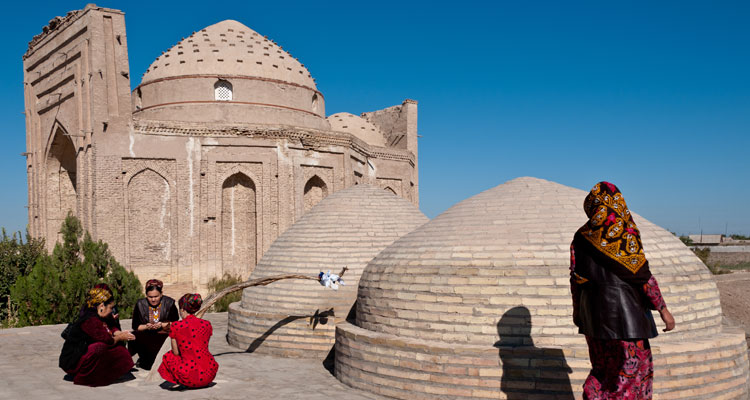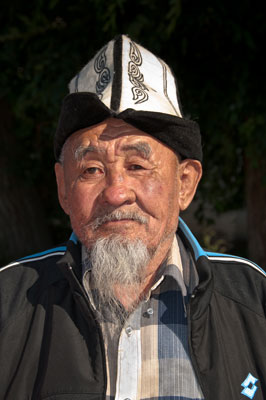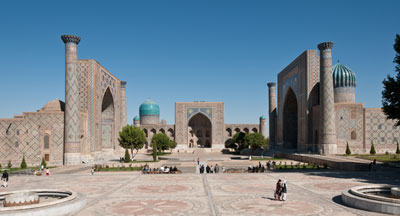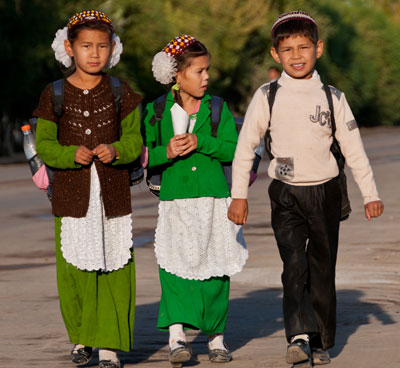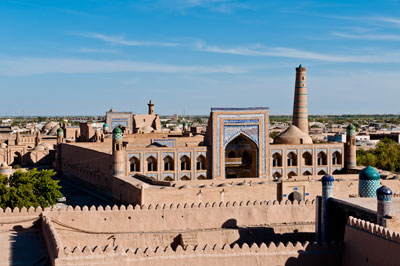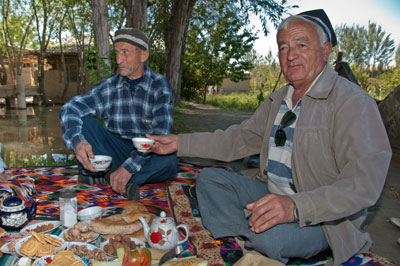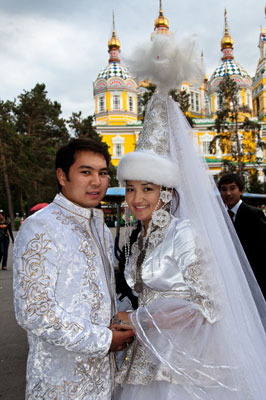Touring the Five ’Stans
by Gordon Kilgore; Sharpsburg, GA
I became interested in Central Asia many years ago when reading about the Silk Road. Bukhara and Samarkand always seemed like mystical places to me. More recently, I read a book about Genghis Khan by Jack Weatherford that made me, more than ever, want to pay a visit to the area.
Planning the trip
While on another trip, in 2009, I met a man and his wife who had recently completed a trip to Central Asia arranged by Irina Chugaevskaya of Aba Sayyoh Tours (M. Usuf Street 52, office 6, Tashkent; phone +988 71 2671796) in Uzbekistan. This couple was most pleased with their experience, so I contacted Irina to see what she could arrange for my wife, Margaret, and me.
Initially, I was not sure exactly what I wanted, but I did know that I did not want to join a large group. While tour operators with groups of 12 to 36 people do provide a certain comfort level, traveling with them makes me feel like a tourist and not a traveler.
Originally, there were to be two other couples joining us, but they both backed out, so it was just Margaret and me with a car, a driver and an English-speaking guide. There were times, such as at airports and border crossings, where we were on our own, but it was only for a very short time.
The tour cost us a bit more than what it would have with six people, but what we gained was flexibility. As a photographer, it was important to me to be able to stop from time to time for photo opportunities. We were able to eat where and when we wanted, stay in small hotels and guest houses in great locations and have one-on-one conversations with our guide. Deviations from the planned itinerary could be arranged and questions asked at any time.
Other than breakfast, we never ate a meal in a hotel, choosing, instead, small places where the locals ate. We were able to visit homes and farms and see life as it really was.
Our trip was 18 days, but if I were to do it again I would make it a few days longer.
A smooth start
We began our trip on Sept. 9, 2010, in Tashkent, Uzbekistan. As Irina promised, when we exited the baggage claim area at the airport there was someone holding a sign with our name on it. In short order, we were off to the Tashkent Palace Hotel. This was perhaps the most expensive of all of our lodgings on this trip, and it was an excellent choice from which to begin and end our tour.
The following day we toured part of Tashkent, then went to the airport for an afternoon flight to Bishkek, Kyrgyzstan, continuing the next day by car to Lake Issyk Kul in the northern Tian Shan mountains. Lake Issyk is about 113 miles long and 37 miles wide, making it the 10th-largest lake in the world by volume and the second-largest alpine lake.
After driving around the north and east sides of the lake, we spent the night at the Green Yard Guest House in Karakol. The Green Yard was a most delightful place, with excellent food served by a gracious host. I particularly liked the old Russian-style wooden houses in Karakol.
Completing our drive around the lake the following day, we then headed north to the Chong-Kemin Valley. Our destination was the village of Chong-Kemin and the Guest House Alpinist. Our room there was in the new addition, and all meals were included.
I spent a half day wandering the village, meeting and photographing some locals, our guide Vitaliya Timchenko doing the interpreting. It was harvesttime in the fields, and people were gathering potatoes and hay.
We departed the Chong-Kemin Valley and stopped at the Sarmysh Gorge to view ancient petroglyphs. Then we drove up into the Jety-Oguz Gorge for a night in a yurt.
A cold front had passed through that day, so it was much colder than we had expected. My thermometer read 36°F inside our yurt the next morning. Frost topped the yurt and covered the ground.
We both had so many quilts piled on top of us that we could barely move. At least there was a fire in the yurt, where breakfast was served.
After breakfast we loaded up and drove to the Kazakhstan border. Our guide and driver had been through this border crossing many times and knew the routine. Still, we had to walk across with our luggage and, on the opposite side, meet the car after it had passed through Customs too. This took about 1½ hours, due to the many people crossing with us.
It was late afternoon when we finally reached Almaty, Kazakhstan. We had just enough time remaining in the day for a city tour, since we were to fly back to Tashkent, Uzbekistan, in the morning. I would allow another day in and around Almaty should I visit again.
Returning to Uzbekistan
Back in Tashkent, we were met by Elena Azaranko, our Uzbekistan guide for the next six days. After seeing more sights in Tashkent and spending another night at the Tashkent Palace Hotel, we drove to Samarkand. Finally, we had arrived at one of the cities that had first enticed me to take this trip.
Samarkand is the second-largest city in Uzbekistan, and in the 14th century it was the capital of the empire of Timur. Samarkand was an important stop on the Silk Road between China and the West. Some wonderful monuments are preserved from that period of time.
The well-preserved and -restored Registan, a complex of three madrassas, was the ancient center of Samarkand.
We spent three nights in Samarkand at the very nice Malika Prime Hotel, which was within sight of Tamerlane’s mausoleum, the Gur-e Amir, and the Bibi-Khanym Mosque.
After two days of touring, we made a day trip to Tajikistan to visit the ancient ruined city of Panjakent. Our guide in Tajikistan was Hamrokul Mirzoev, an English teacher. With his help, this was the easiest and quickest border crossing of the entire trip.
I asked if it was possible to visit someone’s home, and Hamrokul said that he would go ask a farmer who lived nearby. It was about noon on a Sunday when we found Jaliloov Razshan in his yard. He readily agreed to show us his house and farm. He had a house full of relatives and the small kitchen was busy.
After we had toured his farm and house and met the family, Jaliloov asked Hamrokul if we would like some tea. We agreed. Removing our shoes, we sat down on quilts placed on the ground under the shade of nearby trees.
First, two kinds of home-baked bread appeared, followed by a plate of dried apricots, nuts, two kinds of cookies and candy. A dish was brought with brown butter that tasted like cheese.
Jaliloov then got a melon (somewhat like our honeydew but larger) out of the pond, where it had been placed to keep it cool. Our guide proceeded to slice the melon, which was very sweet and delicious — but we were not through. A watermelon was also sliced, and a towel was passed around with which to wipe our hands. (The towel was really needed when we were given a large tomato, which was eaten like an apple.)
Finally the tea was ready, served in handleless cups larger than our typical teacups, which we cradled with both hands.
That morning, Margaret and I had decided to skip lunch to allow extra time for touring. It was a good idea because Jaliloov’s wife brought each of us a big bowl of soup. Margaret decided to pour a little of the soup in her teacup to have a small sample. The soup, filled with vegetables and meatballs mixed with rice, was delicious — so good, in fact, that Margaret ate not only what was in her cup but the balance of the large bowl that was brought to her.
I had read that Tajik people were some of the friendliest in the world, and I can now say, without hesitation, that the members of this family certainly were. I could not help but wonder how many American families could have or would have produced such a spread on the spot without prior warning.
Another quick trip across the border and we were met again by Alina, our Uzbek guide. After spending the night in Samarkand, we made our way to Bukhara, only a few hours away by car.
“Wow!” was my reaction to this magical city. The historic center, which has been inhabited for about 2½ millennia, contains many mosques and madrassas. Some are still functioning, while others are well-preserved monuments. Many of the buildings are from the eighth to 17th centuries.
The historic walled city center is easily explored on foot in a couple of days.
I had thought that Samarkand was my favorite place… until I reached Bukhara. If I had only one place to visit in Central Asia, it would be this city.
Turkmenistan troubles
Next on our itinerary was Turkmenistan for four days. We drove to the Farab border to begin what was the worst border crossing of our entire journey.
First we had to exit Uzbekistan. We presented our passports before entering a building to fill out two Customs declaration forms. The completed forms were inspected and stamped.
After all of our bags were scanned, we walked to the next building, where our passports were checked again and information about us was listed in a book. Finally, our forms and passports were stamped by the exit officer.
A sign read, “Follow the arrows to the neutral zone.” We complied. Upon entering the neutral zone, we had one more passport inspection by an Uzbek border officer, who then pointed down the road in the direction that we were to proceed.
All we could see was a line of trucks waiting to enter Uzbekistan. Beyond that was bushy desert. That was it! Where was the Turkmenistan border? We discovered that it was over a mile away, so off we went, rolling our luggage.
Finally we reached a passport checkpoint. However, the Customs building was still another half mile away. Fortunately, there was a minivan that transported us the rest of the way for $1 — money well spent.
The van delivered us to the building and, after a passport check, we were allowed to enter. Someone handed us a Turkmen Customs declaration form. Once it was filled out and inspected, we proceeded to another area to obtain our visas.
To enter Turkmenistan, as for Russia, one must have a Letter of Invitation, which we had with us from our Uzbek travel agency. However, a Turkmen travel agency representative must show up with an Entry Travel Pass. As we later discovered, our Turkmen guide had the pass with him, but he was not allowed past the outside gate.
We explained to the agents that someone from Ashgabat Siyakhat Travel Agency was there to pick us up and should have the required documents. We had the travel agency’s telephone number, so the visa agents made a call to Ashgabat, about 384 miles away, and our guide was finally allowed to enter to produce the necessary documents.
Finally, everyone seemed satisfied and we each paid the required 55-dollar visa fee plus the entry fee ($12). With the visas finally in our passports, we ran our luggage through the scanner and our passports were checked again. Our Customs declaration form was stamped and collected and, with one final passport check, we were finally allowed to exit the building and enter Turkmenistan. The entire border crossing took almost two hours.
Sites of interest
Of the five countries we visited, Turkmenistan would be the one to which I would not want to return. There seems to be little interest in promoting tourism, perhaps partly because the country has vast natural gas riches. In a sense, I did not feel welcome.
Photography was restricted and access to certain areas was limited. There was almost no Internet access, and it seemed the government controlled everything. It reminded me of Russia before the breakup of the Soviet Union.
Over 70% of the country is covered by the Karakum Desert. Much of the remaining land is planted in cotton, which requires vast irrigation. One of the main roads running through the Karakum is paved with asphalt but was rutted much like a dirt road because the summer temperatures are well above 100 degrees, making the asphalt soft enough that heavy trucks create ruts.
I found four main things of interest for visitors. The first point of interest is the capital, Ashgabat. While it does not surpass Dubai in construction, I saw modern buildings in every direction. The city was full of parks, monuments and trees. Considering that it is a desert city, it boggles the mind to think how much irrigation it must take to keep all of the trees, plants and grass alive.
The streets were wide, with modern vehicles everywhere. There were many high-rise apartment buildings and shops selling Western-style clothing.
Turkmenistan does contain the ruins of two ancient cities. The ancient city of Merv, near the modern city of Mary in southeastern Turkmenistan, was an important stop on the Silk Route. Its archaeological ruins consist of a series of separate and adjacent walled cities, dating from the sixth century BC to the 15th century AD. Some of the walls were visible, as were the remains of a few buildings.
Another place of interest is Nisa, an ancient city located about ten miles northwest of Ashgabat. Excavations have revealed portions of this UNESCO World Heritage Site.
It is said that Nisa was the first capital of the Parthians, around 250-211 BC. The city was destroyed by an earthquake during the first decade BC.
Kunya-Urgench
We departed Ashgabat in the early morning on a flight to Dashoguz. Turkmenistan Airlines is heavily subsidized, so flights are very cheap. (Ours cost less than $20 each.)
We were met by our guide Anna with a car and driver and taken to Kunya-Urgench, situated in northwestern Turkmenistan on the banks of the Amu Daria River. The origins of Kunya-Urgench go back to the sixth or fifth century BC.
The town was located on the crossing of two major trade routes and became an important trading center from the 10th to 14th centuries. Genghis Khan destroyed the city in 1221, but it was rebuilt with fine bazaars and impressive buildings. In the late 14th century the city was ravaged by Timurid troops.
This World Heritage Site has three main attractions: the ruined fortress of Khorezmbag, dating from the mid-19th century; the remains of the Kyrk Molla Fortress, from the fifth century BC, and the 60-meter-high Kutlug-Timur Minaret, the most visible landmark. There are also mausoleums, mosques and Muslim graveyards.
After touring Kunya-Urgench, we drove the short distance to the Turkmen-Uzbek border for our final border crossing of the trip. We encountered no problems there and it took less than an hour to complete. Our new Uzbek guide, Maria, and our driver took us to Khiva for our final two days in Uzbekistan.
Coming full circle
Khiva is an ancient desert oasis, bordered on the south by the Karakum Desert and on the northeast by the Kyzylkum Desert. It was the center of a notorious slave market from the 17th to 19th centuries.
Khiva is divided into two parts: the outer town, called Dichan Kala, which was once protected by a wall, and the inner city, or Itchan Kala, still enclosed by brick walls measuring 10 meters in height.
The Old Town contains historic monuments and old houses dating mainly from the 18th and 19th centuries. Some structures were begun as early as the 10th century and were rebuilt and modified over time. About 50,000 people live in the combined parts of Khiva, the city a photographer’s delight from dawn to dusk.
We took an evening flight to Tashkent, then an early-morning flight to Rome and on to Atlanta.
Excluding visas, the cost of our 18-day tour was $3,200 each, including a car and driver in each country, an English-speaking guide, all admission fees and hotels, lodges, guest houses and yurts, with daily breakfast.
A few of the out-of-the-way lodges and the yurts included all meals as well; otherwise, we paid for our own meals as we went. I do not recall paying more than the equivalent of about $7 for any meal, and many were $3-$4.
Our $3,200 also included four separate flights.
We had a total of six local guides. Five were excellent and we would gladly recommend them to others. (Our first Turkmenistan guide was substandard.) All of the vehicles were in excellent condition, with sufficient room for our gear and guide. All of our guides had cell phones. Excellent planning by Irina made things go very smoothly. I would definitely use Aba Sayyoh again.
Looking back, I would make a few changes should I take this trip again. I would add an extra day in Almaty, Kazakhstan, and an extra day at the end of the trip in Tashkent. Our late arrival in Tashkent that night and a 5:45 a.m. departure the next morning made for a very short night. I believe I would also like a couple of extra days in Tajikistan to visit the mountains.
Mid to late September was an excellent time to visit. Crops were being gathered in the fields and the temperatures were very pleasant. I think that spring would also be a good time for a Central Asia trip, but don’t go in the summer unless you enjoy 100°-plus daytime temperatures.

